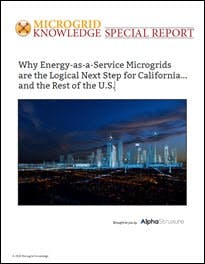Can You Afford to Not Have a Microgrid?
In California, the question ‘Can we afford a microgrid?’ might be more aptly phrased: ‘Can we afford to not have a microgrid?’ This excerpt from a new special report by Microgrid Knowledge and AlphaStruxure highlights how energy-as-a-service is making microgrids easier and more affordable.
Download the full report.
Business executives, community leaders and others often quickly see the value of having the 24/7 energy reliability of a microgrid. But three questions keep them up at night as they consider microgrid adoption.
- Can we afford it?
- How will we build and manage it?
- Will it help us meet our sustainability goals?
In California, the question ‘Can we afford a microgrid?’ might be more aptly phrased: ‘Can we afford to not have a microgrid?’ The state already has among the highest electricity retail rates in the nation, 16.58 cents/kWh compared with the national average of 10.48 cents/kWh, according to the US Energy Information Administration (EIA). (Figures release Dec. 2019)
And electricity costs aren’t likely to go down. In fact, a confluence of factors are putting upward pressure on utility rates in California, including more than $24 billion in utility costs for wildfire-related funds and settlements related to property destruction. As of this writing, the state’s largest utility, PG&E, was seeking permission from state regulators to raise its retail rates by more than $1 billion in 2020.
The second worry of decision-makers — building and managing onsite energy — also is justified. Having control over one’s energy brings many benefits but navigating power technologies and wholesale markets is the sphere of experts. If you’re not in the energy business, it may be difficult for your company to secure and install the equipment, operate and maintain the plant, and capture cost savings opportunities and revenue streams from the market.
The same problems arise in navigating sustainability goals. Achieving emissions reductions from your facility, securing state or federal incentives for doing so, and then verifying and documenting performance, become a substantial effort for those not steeped in the process.
When a business tries to manage a microgrid on its own, it may draw resources away from its core activities. Recognizing this, the energy-as-a-service model was designed to provide customers with the benefits of microgrids without the operational and capital burden.
Source: EIA
Understanding energy-as-a-service microgrids
How does it work? What do you as a microgrid customer need to do?
Under energy-as-a-service, the customer takes on none of the burden associated with the microgrid’s capital investment nor its operations. That’s handled by third-party energy operators and investors who guarantee the performance of the microgrid system. So the customer is spared the work of developing, operating and maintaining the microgrid, and the financial burden of a capital outlay — which is why energy-as-a-service microgrids also are called no-money down projects.
In your financial accounting, the microgrid is recorded as an operational — not capital — expenditure, freeing up capital for other non-energy investments. As the microgrid customer, you simply pay a regular charge for receiving the microgrid benefits — affordability, reliability, resilience and sustainability.
But what will that operational expenditure be? An experienced energy provider, with strong financial backing, will structure your contract to fit your budget goals. In California (and other states where electricity prices are high) your energy-as-a-service contract should result in energy costs that are no higher than what you would otherwise pay — and likely less.
Energy-as-a-service is a business model that provides a customer with the benefits of a microgrid for no money down, avoiding the risk and complexity of construction, ownership and operation. An energy-as-a-service provider builds, owns and operates the system and the customer pays only for the ongoing services it uses from the microgrid.
There are other benefits as well. Your energy-as-a-service contract may assume costs for energy efficiency upgrades, off-site renewables, and load optimization, which can further improve project economics.
Designing an energy-as-a-service contract
What are the mechanics behind an energy-as-a-service contract? How does it lead to an affordable microgrid?
Your microgrid is owned and operated by a knowledgeable third party with robust engineering expertise and financial capabilities. A qualified energy-as-a-service provider must be steeped in understanding about energy contracts, financing, incentives, power outage costs, load management, demand response, demand charges, demand response programs, ancillary services and wholesale market pricing.
Your partner starts by carefully evaluating your operation, energy needs and the true cost you pay for energy. Many organizations do not realize that there are embedded costs for energy beyond the kilowatt-hour charge from the utility. These might be:
- The loss of business due to power outages
- Penalties related to environmental non-compliance
- Missed opportunities for energy efficiency
- Inability to capture revenue streams from the sale of energy or services to the grid from a microgrid
- Missed opportunities to reduce demand charges or participate in demand response or load management programs
The third-party owner can design an energy-as-a-service contract that takes all these costs and savings opportunities into account. The length of the contract can be adjusted to meet the budgeting needs of your operation.
In some cases, companies have multiple facilities in various locations and the energy-as-a-service provider can link them ‘virtually’ or contractually to achieve even greater savings and sustainability.
With an energy-as-a-service microgrid, a company can achieve optimal energy economics while at the same time gaining the benefit of reliable and resilient power.
Energy-as-a-service used for nearly one-third of microgrids
Because the energy-as-a-service model makes microgrid adoption easy, it is expected to speed development of the technology worldwide. Already 31% of total microgrid capacity operates under this business model, according to Navigant Research.
With energy-as-a-service microgrids become the next logical step in securing reliable energy, an important step for California — and the world, as we’ll discuss in the next chapter.
See the first entry in this article series that covers whether energy-as-a-service microgrids are the next logical step for California, and for the rest of the country as well. The second explores how microgrid growth appears to have reached an inflection point.
And stay tuned. This special report series will also explore in the coming weeks:
- What businesses and institutions need to consider as they make decisions about energy costs, reliability and sustainability
- How energy-as-a-service contracts work and real-world examples
We invite you to download, “Why Energy-as-a-Service Microgrids are the Logical Next Step for California…and the Rest of the U.S,” free of charge, courtesy of AlphaStruxure. And we encourage you to share this link widely to help educate California — and the rest of the U.S. — about energy-as-a-service microgrids.

